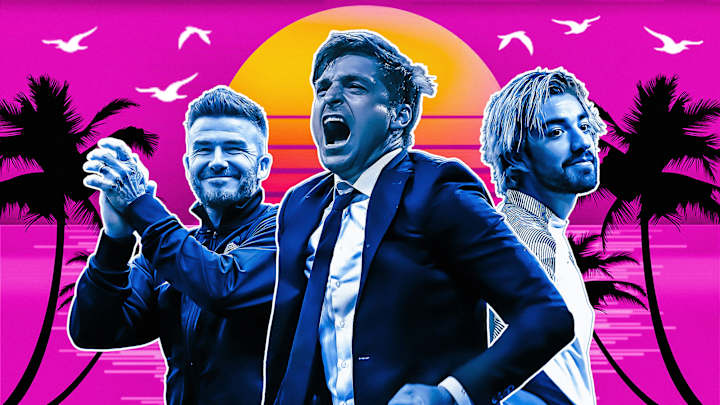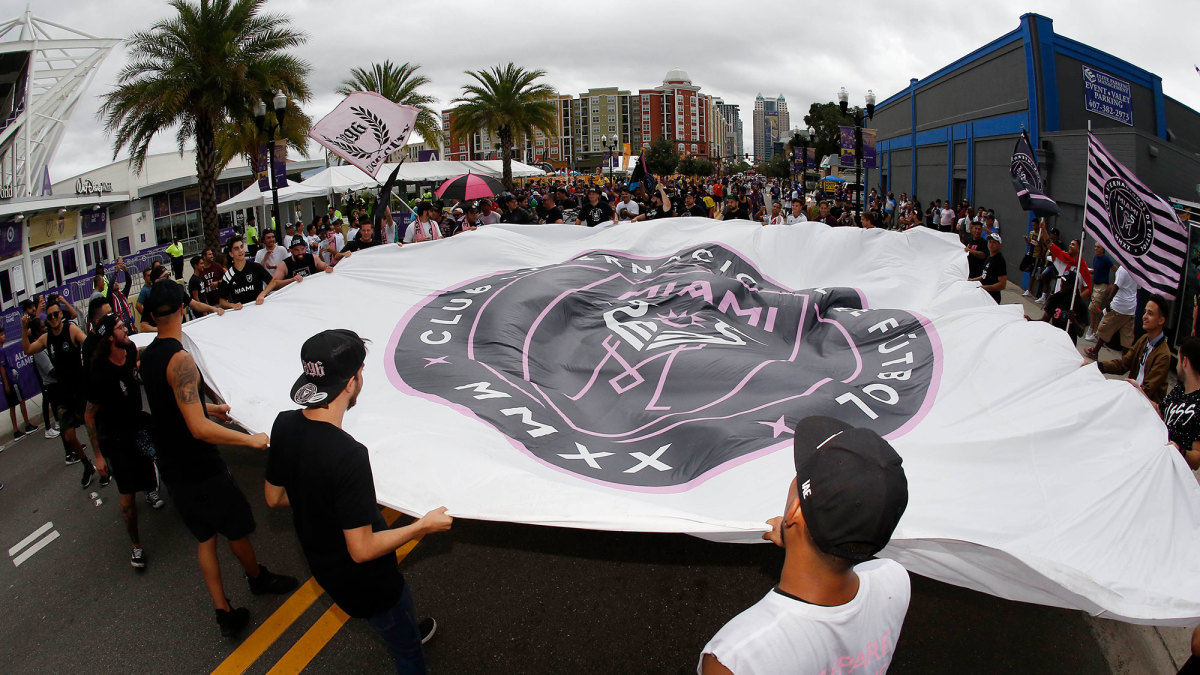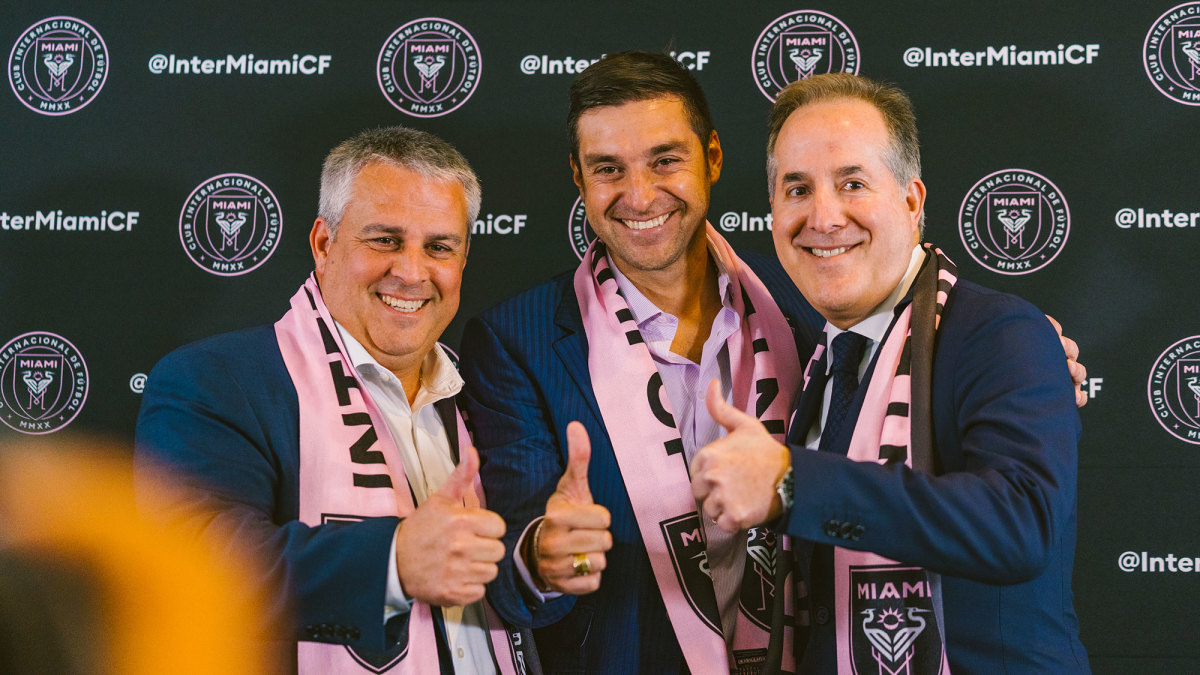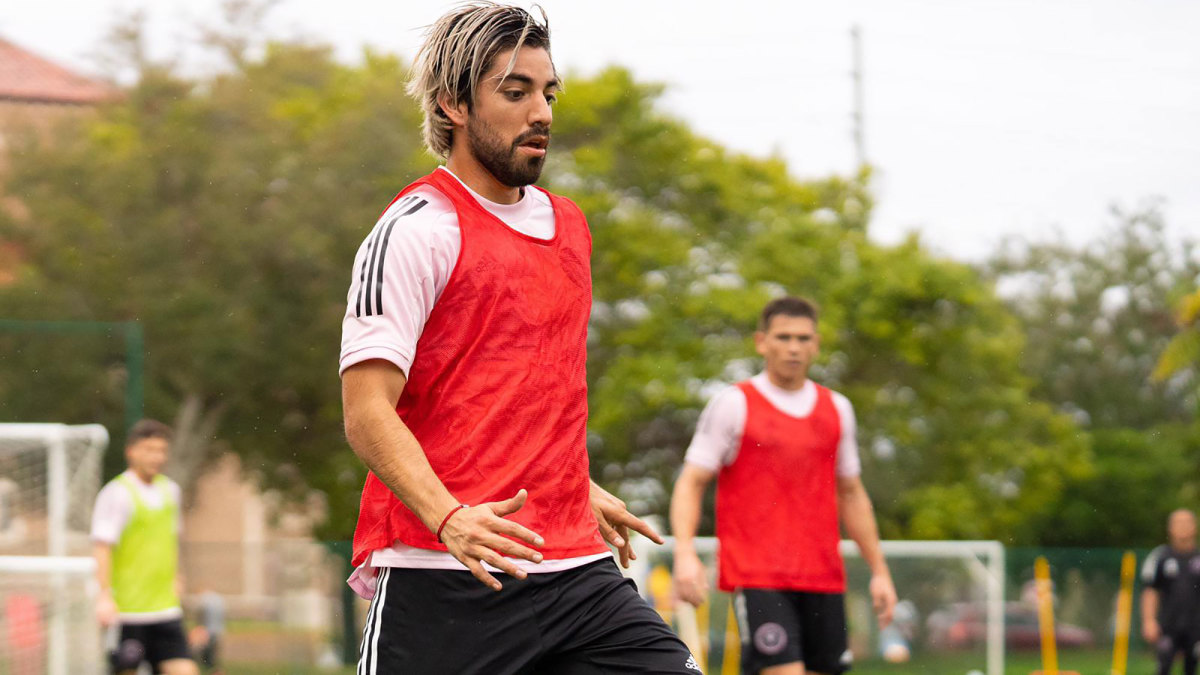Inter Miami's Intrepid, Imperfect Road to MLS

Inside the Mandarin Oriental Hotel in midtown Manhattan, a cautiously animated David Beckham reflects on a seven-year dream that’s days away from becoming a reality. Club Internacional Fútbol de Miami—better known as Inter Miami—will finally see the field in MLS, and Beckham, standing alongside business partner and fellow co-owner Jorge Mas, has one clear emotion.
“I’m excited, I’m excited," Beckham says. "To be coming into this weekend and heading into our first game, I couldn’t be prouder and couldn’t be more excited."
Beckham knows there have been plenty of hurdles along the way—with some still to clear—and there were points when he thought the entire project would crumble.
“But the one person that changed that is this person right here,” Beckham says, pointing to Mas. “That was the one thing that changed everything for me. And this has been a journey that I knew would be worth it, and it’s one thing I never gave up on, because I knew that eventually it was going to happen. I didn’t know when, I didn’t know how long. I didn’t expect it to take seven years, but I knew it was going to be worth it. So, in terms of obstacles there’s been many. From talking to the politicians to finding the right place for our stadium and training facility, bringing in players, bringing the manager, to even things like how’s the sign going to look in our training facility … but the person that changed this whole project is this man.”
Beckham is not wrong about the difficulty in finding the right location. After failing to finalize deals at multiple locations, the club's dream of building a state-of-the-art stadium as part of the proposed Miami Freedom Park project on the site of the Melreese golf course near the airport is still on hold, with another political victory required. Because nothing has become easy, hazardous levels of arsenic waste were discovered on the 131-acre piece of land, making things even more problematic—and costly.
For now, the club does have a stadium, albeit in Fort Lauderdale at the site of the old Lockhart Stadium, where MLS's first Miami team, the Fusion (1998–2001) used to play. Mas said Wednesday that he doesn’t expect the team to play at the facility, whose long-term future is that of housing the club's USL team and Inter Miami's training facility, for longer than three years. For the moment, it is more than a respectable temporary home.
“When our fans see our facilities on March 14 [Inter Miami’s home opener vs. the L.A. Galaxy], they’ll see how we’re doing things a little bit differently," Mas said. “We’re trying to be trendsetters in the league by having the best facilities in the United States. There’s a Miami way of doing things, and we want to introduce the world to Miami, starting this Sunday [the club's first match, at LAFC].”
Location issues aside, the club's name itself has also been subjected to drama. Inter Milan recently received a favorable ruling as it attempts to gain trademark protection for the word "Inter" as part of an ongoing legal battle that remains in flux. From MLS's initial declaration that it would return to Miami in 2014 to the realization of that statement in 2020, it's been a bold ride overflowing with detours.
Nevertheless, Beckham and Mas remain stoic in their mission to help revitalize soccer culture in a city that breathes the sport through its local communities. From South Beach to Overtown, Brickell to Little Havana, Miami is a fútbol city. It’s just been sitting in the shadows, away from the heat, just waiting for a moment like this.

**********
As an original member of Vice City 1896, one of Inter Miami’s official supporters’ groups, Christian Sarrafiore recalls the exact moment when he realized the club had finally arrived in MLS. It was last season’s All-Star Game in Orlando, and Vice City, alongside the two other official groups, The Siege and Southern Legion, showed up to Exploria Stadium ready to introduce themselves to the league.
“It was pretty much the first time we were all together. We were still growing and developing on our own. Nobody has really even heard of Inter Miami yet. We hadn’t even practiced our chants, but we decided to get together and sing our hearts out,” said the 36-year-old Sarrafiore, who alongside the rest of Vice City (at that time it was around 40-50 members) decided to sing “Y Dale Alegría a Mi Corazón,” a chant synonymous with Argentine soccer culture. “We unveiled an Inter Miami flag and we could see other people in the stadium were saying, ‘What are these dudes doing?' ”
But what most didn’t realize is that moment gave Inter Miami fans a symbolic introduction to the league. It made them feel like they belonged.
“I think that’s where the league took notice. And that’s honestly all we had to live on, it gave us hope,” Sarrafiore said.

Fast-forward another seven months, and Inter Miami fans are no longer relying on hope, nor are they celebrating by themselves. Whether it’s a barbecue, pickup matches or meet-ups to practice chants, Vice City’s events now feature approximately 150 people, and the team has taken it all in. Shortly before the club’s final preseason game, vs. the Tampa Bay Rowdies, players joined Vice City and other fans outside the team’s hotel in St. Petersburg to chant and celebrate. Argentine center back Nico Figal even picked up the drum.
Inter Miami defender Nico Figal on drums.. players chant and bang drums with fans before game.. great scene you would never see in NBA or NFL. @InterMiamiCF @MiamiHerald @HeraldSports @MLS pic.twitter.com/i60Urkx0BM
— Michelle Kaufman (@kaufsports) February 23, 2020
The euphoria is here. The anxiety is here. Miami, a city rich in footballing culture with a resonant Latin American and international demographic, is days away from a historic debut, and this is finally a chance for passionate fans like Sarrafiore, who was born and partly raised in Argentina, to showcase it on the MLS level for the first time in nearly two decades.
“A lot of times Miami gets a reputation for being a bandwagon town, and soccer is the opposite of that," Sarrafiore said. "We want to change the mind-set of what it means to be a Miami sports fan. We want to go the stadium every other Saturday and watch the team and make people fall in love with what they had wherever they grew up: the beautiful feeling of being at the stadium. That’s what we miss.”
While there are celebrations, there is still a lot of work to do. If you were to ask sporting director Paul McDonough what it’s been like in his shoes this past year, he would probably tell you that he could use an eighth day of the week.
“It’s been really busy," McDonough said. "We’re in the final stages of construction, trying to get the final pieces of the roster finished. ... From making sure the training facilities and the stadium are open to getting everybody settled and we can just get down to focusing on games and playing.”
The 50,000-square foot training complex in Fort Lauderdale, which houses all of the club’s teams, ranging from the U-13 academy payers to the first team, is something he’s especially proud of. In fact, one of his favorite moments is when Mas comes to visit.
“I always feel good when he comes to visit after not having seen it for a month," McDonough said. "Jorge comes in and he looks so excited, so I feel really good I spent his money well. And I’ve spent a lot of his money.”
Night time view from field of your @InterMiamiCF stadium: Thank you to Fort Lauderdale mayor, commissioners and staff. March 14th all eyes are here. Picture from site August 6th puts in perspective progress made. pic.twitter.com/INUeP43nrX
— Jorge Mas (@Jorge__Mas) February 13, 2020
Much of that cash has gone into the training facility and the 18,000-seat stadium. It may not be Mercedes-Benz Stadium in Atlanta, but McDonough believes it can become a mini fortress for the club.
“The fact that we were able to get it up and running in nine months ... and how nice it is for nine months, that’s great," McDonough said. "It’s not a modern stadium in the sense that it doesn’t have some of the amenities, but I think it’s a beautiful field, the seating bowl is great, it’s going to be loud, and the most important thing for me is that it gets us playing in a non-baseball stadium.”
McDonough’s main responsibility of filling the roster has come with some obstacles. There's room for one more designated player, but that signing probably won’t come until the summer at this point. In addition, 19-year-old Argentina forward Julian Carranza’s injury will keep him out until at least May, changing the calculus in the attack. It provides opportunities for No. 1 SuperDraft selection Robbie Robinson, Juan Agudelo and Jerome Kiesewetter to impress. But as much as they can offer, there’s little to believe they can provide the same kind of goal-scoring threat.
“I’m worried about the No. 9 role," McDonough said. "Carranza’s injury puts it into a different light. I think we’ve become very light there. I feel comfortable we have depth in all the other spots, but that one without Julian, I think if we had Julian, we would feel pretty good. I don’t really want to wait until the summer to add a No. 9, so I want to get it in as soon as possible. You have to have a guy like Josef Martínez that can come in and get you 25 goals if you expect to be anything serious in MLS.”
It’s no secret that Club América’s Roger Martinez has been a target, and reports state that Miami has reignited its interest in the Colombian attacker. Recently, Martinez did state his loyalty to the Mexican club despite not having played all season, with Miguel Herrera not deploying him until his situation is resolved. Another player who fits the bill is Sebastian Driussi, the dynamic 24-year-old Argentine striker currently with Zenit Saint Petersburg. McDonough says the club was close to signing him, but it fell through, hinting at political reasons but also stating that Zenit didn't want to sell with the club fighting for a Russian top-flight title and Champions League qualification.
"That one hurt for me, because I think his signing would have been so great for the league,” McDonough said.
One who didn’t get away is Rodolfo Pizarro, the 26-year-old Mexican star who came from Monterrey. When McDonough talks about his second DP–19-year-old Argentine attacking prospect Mattias Pellegrini being the first–he’s still somewhat in disbelief that he's signed. Not too long ago, he thought bringing him to Miami was almost impossible.
“The fact that we could get him is honestly a major statement for the club," McDonough said. "He wasn’t even on our list of players, but then when we found out he was interested in the league, we jumped on it really, really quick.”
The first phone call McDonough made was to Gerardo "Tata" Martino, a man he knows so well from their days at Atlanta United and the current Mexico national team coach.
“I wanted to know his opinion, as he knows Pizarro well from the Mexican national team," McDonough said. "And Tata said this to me, just like when he said this to me about one other player: 'Paul, Miguel Almirón es un crack (Spanish soccer slang for exceptional) and Pizarro también es un crack.' "
McDonough is realistic about the club’s early ambitions and thinks in a league where seven teams in each conference make the playoffs, playing deep into October is not out of reach. This squad, he says, is good enough to make a run in the U.S. Open Cup, a tournament that offers a pathway to the Concacaf Champions League. And that is a major priority.
“This is why I spent the first part of the roster build in trying to really strengthen roster spots 15 through 25, because I think you need those pieces to make a deep run into the U.S. Open Cup,” McDonough said.
There is optimism in McDonough’s voice, but he knows success depends on strengthening the squad and making sure its manager, Diego Alonso, adapts to the league. For a man who helped Orlando and Atlanta get off the ground, it's fair to say that Miami is his toughest test yet.
**********

When Alonso first met with McDonough, the first thing that came out of the meeting was an immediate understanding of Inter Miami’s vision.
“After leaving Monterrey, I wanted a winning project. So, I won in Pachuca, I won in Monterrey and wanted to keep winning. After the interview, I was able to see Inter Miami’s project and honestly fell in love with it, I felt connected to it from experience.” says the 44-year-old Uruguayan, whose résumé includes multiple titles with Pachuca and Monterrey and becoming the first manager to win the Concacaf Champions League with two clubs. “When I first came here, the first interview I had with Paul, we talked about the team and what it will look like, and he had a certain idea, and, obviously, it was something I liked as it related with how I see the game. I felt his ideas represented my own, that’s why we agreed.”
Alonso saw what McDonough did with Atlanta and how his relationship with Martino became a fundamental part of the club’s success, and he felt another unique bond could be created in Miami. Despite the mutual admiration between head coach and employer, the hiring of Alonso did seem late in the process, especially since many players had already either arrived or been announced months before the manager himself.
The initial approach for Alonso came around late-November, and his official announcement wasn’t until Dec. 30, weeks before the start of preseason. As a result, the team has had to speed things up and use the last two months as a time to not just learn how to play together, but how to literally be together. But Alonso loves this type of work. He is a quintessential man-manager who prides himself on developing character on and off the field.
“Even more than just the style of play and how it will look on the pitch, the most important thing is the mentality," Alonso said. "There are priorities between how one wants to play and what the mentality should be, and they both should go hand in hand.
"In order to compete at a high level, you need to compete every minute, win every play in order to get the final result. I think that’s going to be the most important characteristic—to not be a team that responds, but rather a team that proposes. That proposes to look for the fight in matches and then look to win.”
Alonso asked for patience and feels that fans should be able to see a better idea of the team’s identity after things are a bit more settled.
“We still need players, no doubt," Alonso said. "But the work the players have done has been extraordinary. We still need to do much more, but from day one to now the growth has continued to elevate.”
What’s helped immensely, he says, is the support of the fans. When you’re a Latin American manager leading a club with a clear Latin American identity and living in a city with a strong Latin American identity, there's an immediate sense of unity.
“To be in this environment, a mix between Latinos and non-Latinos, is motivational," Alonso said. "We’re so happy. The reception has been tremendous, exceptional. Whether it’s on the street or anytime we talk to a fan, it’s an incredible atmosphere here in Miami. We know that we have a great responsibility in every match that we play, but in our home games, we have an extra incentive—we have to dedicate every home game to our fans.”
For Alonso, taking over Inter Miami is a significant opportunity for a young manager to create something truly unique, truly Miamian.
“This is one of the biggest decisions I have ever made in my career," Alonso said. "I am very proud to defend this project and to be able to have this dream we all share, to eventually create a winning team.”
**********

It’s arguable that out of any Mexican player who has made his way to MLS, Pizarro’s arrival could be the most significant from a strictly footballing perspective. He may not be as marketable as Chicharito or Carlos Vela, but Pizarro arrives in his prime, with a very strong résumé (three-time Liga MX and two-time Concacaf Champions League winner) and a winner's mentality. Martino’s name once again surfaced when discussing the factors in his signing with the club.
“I always speak with Tata, and I spoke to him about this move," Pizarro said. "I asked his opinion, what he thought of the league, and he thought it was practically in the same level with Liga MX, and that calmed me and reassured me to come here.”
While it’s not necessarily true that MLS is at Liga MX’s level, it’s getting there, and that’s something that seemed appealing to Pizarro. His personal goal is simple: help Miami win and continue to improve to eventually attract European attention.
“This is an opportunity for me to grow and to develop. To raise my football and to be seen, to be noticed by a bigger audience,” said Pizarro, who’s made no secret about seeing this opportunity as a stepping stone to reach his European dream. “I want to win titles with Inter Miami, go to the World Cup with Mexico and then we’ll see. For now, I’m fully focused on this club.”
He doesn’t have a timeline for how long he sees himself with Inter Miami, but the club definitely wants to make the most of its hefty purchase. It reportedly paid $12 million and essentially doubled Pizarro’s wages, and it took clearing a few hurdles for him to come to the club.
Aside from Monterrey’s initial reluctance to sell, there was also the issue of the approach. When Pizarro arrived at Miami International Airport on Feb. 13, he took time to talk to fans and the press, describing his excitement over joining the expansion side and how video chats with Beckham persuaded him to come to the club.
This in itself became an issue with Monterrey’s sporting director Duilio Davino, who on the same day of Pizarro’s arrival stated that Beckham's calls were against FIFA regulations due to the fact that the player still had a contract with the Liga MX club.
Weeks later, when asked more about the conversation with Beckham, Pizarro remained more cautious in his answer, saying that to be called by someone like Beckham is an honor.
“He told me he was happy with me coming here, that I was going to be important and honestly, to have someone like him—with his personality and everything he’s achieved—just the fact that he bothered to call me and talk to me makes you feel important, valuable. And that influenced me,” Pizarro said.
After his arrival, Pizarro’s official announcement, which was scheduled for the following day, stalled as both the club and player had to wait for immigration papers to be finalized. Nevertheless, Pizarro was ready to train with Miami, which was preparing for a preseason game against Philadelphia Union the next day. Pizarro played and scored in that game but because he wasn’t announced yet, Inter Miami’s social media team couldn’t even tweet out his name.
Scoring a goal before being officially introduced by your new team seems like a first, but now that the initial frenzy has calmed down, all Pizarro wants to do is play and show the league that Miami has arrived.
“I love Miami. It’s so Latino. It feels at home. And you can feel the football. And that’s important, for the fans to support us all the way,” Pizarro said.
For Beckham, Pizarro’s words are emblematic of the club's mission. It's not only about the star players that may or may not come to Miami, or solving its stadium issues and other legal hurdles, but rather about rejuvenating soccer culture through a Latin American thread and nurturing the grassroots movement of young local talent.
“I don’t think there will be a prouder moment for us than when we see homegrown talent come through the ranks, come through the academy and step on to that MLS pitch and step into our stadium in Fort Lauderdale or years later in Miami," Beckham said. "This is what we wanted to do. Give the young kids of our city the opportunity to play at the highest level and that’s all we want to do.”
So, when Inter Miami celebrates its long-awaited debut, fans from all over South Florida might want to take a moment to reflect and realize that this arduous journey came with intrigue, controversy and a whole lot of noise.
And you can’t get more Miami than that.
